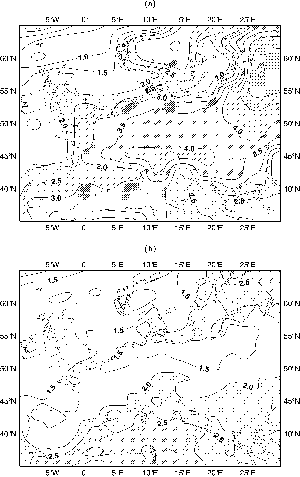|
Box 10.2: Tropical cyclones in current and future
climates
Simulating a climatology of tropical cyclones
Tropical cyclones can have devastating human and economic impacts (e.g.,
Pielke and Landsea, 1998) and therefore accurate estimates of future changes
in their frequency, intensity and location would be of great value. However,
because of their relatively small extent (in global modelling terms) and
intense nature, detailed simulation of tropical cyclones for this purpose
is difficult. Atmospheric GCMs can simulate tropical cyclone-like disturbances
which increase in realism at higher resolution though the intense central
core is not resolved (e.g., Bengtsson et al., 1995; McDonald, 1999). Further
increases of resolution, by the use of RCMs, provide greater realism (e.g.,
Walsh and Watterson, 1997) with a very high resolution regional hurricane
prediction model giving a reasonable simulation of the magnitude and location
of maximum surface wind intensities for the north-west Pacific basin (Knutson
et al., 1998). GCMs generally provide realistic simulation of the location
and frequency of tropical cyclones (e.g., Tsutsui and Kasahara, 1996;
Yoshimura et al., 1999). See also Chapter 8 for
more details on tropical cyclones in GCMs.
Tropical cyclones in a warmer climate
Much effort has gone into obtaining and analysing good statistics on tropical
cyclones in the recent past. The main conclusion is that there is large
decadal variability in the frequency and no significant trend during the
last century. One study looking at the century time-scale has shown an
increase in the frequency of North Atlantic cyclones from 1851 to 1890
and 1951 to 1990 (Fernandez-Partagas and Diaz, 1996). See Chapter
2 for more details on observed tropical cyclones.
Most assessments of changes in tropical cyclone behaviour in a future
climate have been derived from GCM or RCM studies of the climate response
to anthropogenically-derived atmospheric forcings (e.g., Bengtsson et
al., 1996, 1997; Walsh and Katzfey, 2000). Recently, more focused approaches
have been used: nesting a hurricane prediction model in a GCM climate
change simulation (Knutson et al., 1998); inserting idealised tropical
cyclones into an RCM climate change simulation (Walsh and Ryan, 2000).
In an early use of a high-resolution AGCM, a T106 ECHAM3 experiment simulated
a decrease in tropical cyclones in the Northern Hemisphere and a reduction
of 50% in the Southern Hemisphere (Bengtsson et al., 1996, 1997). However,
the different hemispheric responses raised questions about the model’s
ability to properly represent tropical cyclones and methodological concerns
about the experimental design were raised (Landsea, 1997). In a similar
experiment, the JMA model also simulated fewer tropical cyclone-like vortices
in both hemispheres (Yoshimura et al., 1999). Other GCM studies have shown
consistent basin-dependent changes in tropical cyclone formation under
2xCO2 conditions (Royer et al., 1998; Tsutsui et al., 1999).
Frequencies increased in the north-west Pacific, decreased in the North
Atlantic, and changed little in the south-west Pacific. A high resolution
HadAM3a simulation reproduced the latter changes, giving changes in timing
in the north-west Pacific and increases in frequency in the north-east
Pacific and the north Indian basin (McDonald, 1999). Some GCM studies
show increases in tropical storm intensity in a warmer climate (Krishnamurti
et al., 1998) though these results can probably not be extrapolated to
tropical cyclones as the horizontal resolution of these models is insufficient
to resolve the cyclone eye. The likely mean response of tropical Pacific
sea surface warming having an El Niño-like structure suggests that
the pattern of tropical cyclone frequency may become more like that observed
in El Niño years (see Chapter 9).
An indication of the likely changes in maximum intensity of cyclones
will be better provided by models able to simulate realistic tropical
cyclone intensities. A sample of GCM-generated tropical cyclone cases
nested in a hurricane prediction model gave increases in maximum intensity
(of wind speed) of 5 to 11% in strong cyclones over the north-west Pacific
for a 2.2°C SST warming (Knutson and Tuleya, 1999). The RCM study
of idealised tropical cyclones (in the South Pacific) showed a small,
but not statistically significant, increase in maximum intensity (Walsh
and Ryan, 2000). These results are supported by the theory of the maximum
potential intensity (MPI) of hurricanes (Emanuel, 1987). A calculation
using the MPI framework of Holland (1997) suggested increases of 10 to
20% for a 2xCO2 climate (Henderson-Sellers et al., 1998). This study also
acknowledges physical omissions that would reduce this estimate though
Emanuel (2000) suggests there is a linear relationship betweeen MPI and
the wind speed of real events. Published modelling studies to date neglect
the possible feedback of sea surface cooling induced by the cyclone. However,
a recently submitted study using a hurricane model with ocean coupling
indicates that the increased maximum intensity by CO2 warming
would still occur even when the sea surface cooling feedback is included
(Knutson et al., 2000).
The extreme precipitation associated with tropical cyclones can also
be very damaging. The very high resolution studies discussed above suggest
that increases in the intensity of tropical cyclones will be accompanied
by increases in mean and maximum precipitation rates. In the cases studied,
precipitation in the vicinity of the storm centre increased by 20% whereas
peak rates increased by 30%. Part of these increases may be due to the
increased moisture-holding capacity of a warmer atmosphere but nevertheless
point to substantially increasing destructive capacity of tropical cyclones
in a warmer climate.
In conclusion, there is some evidence that regional frequencies of
tropical cyclones may change but none that their locations will change.
There is also evidence that the peak intensity may increase by 5% to 10%
and precipitation rates may increase by 20% to 30%. There is a need for
much more work in this area to provide more robust results.
|
